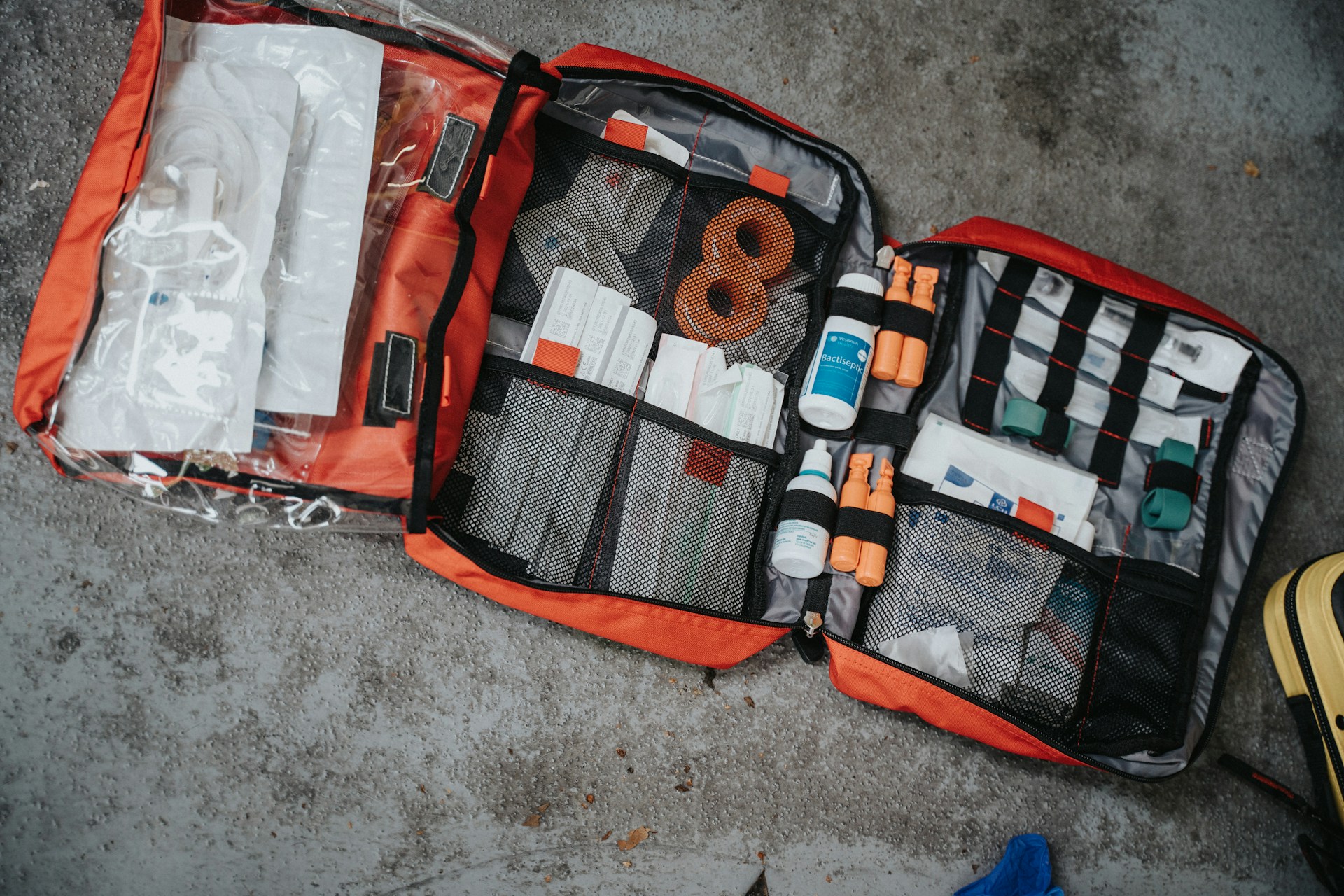Preparedness
Medical Preparedness: Beyond the Basic First Aid Kit

When preparing for medical emergencies away from home, many people stop at purchasing a first aid kit. While these kits serve as a good foundation, they often fall short of comprehensive preparedness.
To truly be ready, it’s crucial to start by taking a basic first aid course. These courses are generally affordable and sometimes even free through civic groups or employers. Typically lasting 6-8 hours, they are designed with the assumption that Emergency Medical Services (EMS) are readily accessible.
However, for those who anticipate being in more isolated or challenging environments, a wilderness or remote first aid course is highly recommended. These courses, usually spanning two days, cost around $200, though community colleges may offer more economical options. They are tailored to equip you with the skills needed to handle medical emergencies when EMS could be delayed by up to 8 hours.
Pet owners should also consider a basic first aid course for dogs and cats. Larger pet stores often provide in-person classes, and the Red Cross offers online options for both pet and human first aid.
At home, having a well-organized and stocked first aid kit is essential. Whether you purchase a pre-made kit or assemble one yourself, it should complement your usual home medical supplies. The contents should reflect your medical knowledge and skills.
For “away from home” emergencies, focus on assembling two kits: a compact one for daily carry in a purse, briefcase, or commuter bag, and a slightly larger one for your 72-hour survival bag, commonly known as a Bug Out Bag (BOB). This bag goes by various names, including 72-hour kit, battle box, grab bag, go bag, GOOD bag (get out of Dodge), INCH bag (I’m never coming home), personal emergency relocation kit (PERK), or quick run bag (QRB).
The compact first aid kit should fit in a small zippered pouch. The M2 BASICS 150 Piece First Aid Kit is a solid choice, though it may require some customization. Consider removing the CPR mask, as current guidelines prioritize chest compressions. Instead, add pain relief tablets, sting relief, and other medications such as antacids, antidiarrheals, or cold remedies. Use small ziplock bags to organize multiple doses, labeling them with contents, dates, and standard dosages, or opt for single-use foil packs. A small tube of triple antibiotic ointment is also a valuable addition. Aim to keep this kit under 8 ounces.
Creating your own compact kit offers the flexibility to tailor it to your specific needs and available space. Soft-sided pouches, like pencil cases or small cosmetic bags, are preferable due to their packing flexibility. This kit is intended for everyday carry, not for your survival bag.
Essential items for your compact kit include:
– Various sizes and types of band-aids
– Self-Adherent Cohesive Bandage, also known as Coban™ or Vet Wrap, which can be used to secure gauze pads, wrap sprains, or hold splints
The goal of these kits is to sustain you through the initial 72 hours of an emergency. It’s important not to skimp on quality; even a simple band-aid should be reliable.
For your 72-hour bag, start with a sturdy, lightweight container. Soft pouches are recommended for their packing efficiency. You can find empty marked first aid bags to ensure easy identification during emergencies.
In addition to the compact kit items, include:
– Travel-sized tubes or containers for medications, ensuring you have at least a dozen of each type
– Hemostatic agents like Quick Clot gauze for severe bleeding
– Feminine hygiene products, space permitting
Customize your first aid kit to match your skill level. A full trauma or EMT kit is only useful if you know how to use the items.
Lastly, consider keeping duplicate first aid kits in each vehicle you own. This ensures you have access to essential supplies even if your Go Bag isn’t with you during an emergency.
Let us know what you think, please share your thoughts in the comments below.

Off The Grid
10 Foods That Could Save Your Life When Crisis Hits

When a real emergency strikes, the first thing most people lose is access to fresh food. Storms shut down roads, power outages spoil everything in the refrigerator, and grocery shelves empty faster than anyone expects. Having the right foods stored can turn a dangerous situation into something you can manage calmly. The key is choosing items that last a long time, do not require refrigeration, and can give your body the energy it needs when conditions get tough.
Here are ten simple, affordable foods that could literally keep you alive when everything else disappears.
1. Canned Beans
Canned beans are one of the most complete emergency foods on the planet. They are packed with protein, fiber, and slow-burning carbohydrates. They can be eaten cold right out of the can if there is no power. Black beans, kidney beans, chickpeas, and pinto beans all work the same way.
2. Rice
Rice is a survival classic because it lasts for years, stores easily, and gives steady energy. White rice stores longer than brown rice, but both are excellent. Combined with beans, rice becomes a complete meal that keeps you full and focused during tough situations.
3. Peanut Butter
Peanut butter is calorie-dense, shelf-stable, and requires zero preparation. A single spoonful provides fat, protein, and fast energy. It can stay good for months after opening if stored in a cool place. In any emergency, peanut butter becomes a go-to survival powerhouse.
4. Canned Meat
Tuna, chicken, salmon, and Spam all offer long-lasting protein that does not require cooking. Canned meat keeps hunger away and helps your body stay strong when facing stress. Always keep a few cans in your emergency kit or pantry.
5. Oats
Oats are cheap, filling, and versatile. You can eat them hot if you can boil water or cold by soaking them for a few minutes. They give long-lasting energy and help keep your stomach comfortable during stressful times.
6. Shelf-Stable Milk
Powdered milk or boxed shelf-stable milk are lifesavers when refrigeration is gone. They provide calcium, protein, and comfort. Powdered milk lasts the longest and takes up the least space, making it an ideal survival-food staple.
7. Pasta
Pasta stores extremely well and is easy to prepare. Even if you cannot fully boil it, soaking pasta in hot water will make it soft enough to eat. It is a reliable way to stretch meals and keep energy levels steady.
8. Honey
Honey lasts forever. It never spoils and can still be eaten decades later. It boosts energy, soothes sore throats, and adds flavor to otherwise bland survival meals. A small jar goes a long way and can lift morale when days feel long and stressful.
9. Canned Vegetables
Fresh produce is the first thing to disappear during a crisis. Canned vegetables fill that gap with vitamins and hydration. Corn, peas, mixed vegetables, and green beans all store well and give your body the nutrients it normally gets from fresh groceries.
10. Water
No food matters without water. Store at least one gallon per person per day. Bottled water, water jugs, and water purification tablets all belong in your emergency kit. If you have space, keep extra. When the tap stops working or becomes unsafe, clean water becomes the most valuable survival item you own.
Final Thoughts
These ten foods are not fancy and they are not expensive, but they can keep you alive when normal life breaks down. Building a simple survival pantry does not require fear or extreme prepping. All it takes is a few smart choices, a little extra storage space, and the peace of mind that comes with knowing you can take care of yourself no matter what happens outside.
Preparedness
Surviving a Winter Snowstorm: What to Do and What to Avoid

A strong winter storm can bring life to a standstill in just a few hours. Heavy snow, sudden freezes, and unpredictable winds can turn familiar streets into unfamiliar terrain. For people over 50, the risks climb even higher because cold weather affects circulation, balance, and stamina, and a simple power outage can create real danger. Preparing ahead of time and knowing what not to do can make all the difference when the weather turns harsh.
Below are five smart steps that protect your safety, followed by five common mistakes that can put you at risk.
Five Things You Should Do
1. Winter-Proof Your Home Before the Storm Hits
As soon as a storm warning appears, walk through your home with purpose. Check that windows are closed tightly and drafts are sealed. Gather warm layers, heavy blankets, and a backup heating option such as a safe indoor propane heater or electric space heater. If you rely on medications, make sure you have enough to last a full week in case roads close or pharmacies lose power. Keeping your home warm is not just about comfort. Cold rooms increase blood pressure, stiffness, and the risk of hypothermia.
2. Keep Your Devices Fully Charged
Power outages are more common in winter than any other season. Charge phones, tablets, power banks, and flashlights before the snowfall starts. A portable battery pack can be a lifeline for communicating with family or emergency services. Even if you think you will be fine, it is better to have full batteries than to scramble in the dark once the electricity goes out.
3. Stock an Emergency Kit You Can Reach Quickly
Your emergency kit should be easy to grab and not buried in a closet. Include bottled water, ready-to-eat food, a flashlight, extra batteries, a battery-powered radio, first-aid supplies, and any personal items you rely on. Add warm socks, gloves, and a hat. During a snowstorm your home can feel colder than you expect, especially if the heat goes out. Even something as simple as dry socks can prevent a dangerous drop in body temperature.
4. Stay Inside Unless It Is Truly Necessary
Walking on ice or deep snow is one of the fastest ways older adults get injured. A single slip can mean a broken hip, sprained wrist, or concussion. If you must go outside, move slowly and deliberately. Use slip-resistant boots and take small steps. Avoid shoveling if you have heart issues or high blood pressure because the sudden exertion in cold air can put serious strain on the heart. If the snow is heavy, ask a neighbor for help or hire a local plow service.
5. Keep Hydrated and Eat Warm Meals
It is easy to forget to drink when it is cold, but dehydration worsens fatigue and weakens your immune system. Drink water steadily throughout the day, even if you are not thirsty. Warm meals such as soups, oatmeal, stews, and hot tea help maintain body temperature and energy. If the power goes out, canned soups and instant meals made with boiled water can still keep you nourished.
Five Things You Should NOT Do
1. Do Not Use Outdoor Heaters or Grills Indoors
During outages, people sometimes turn to charcoal grills, propane grills, or gas-powered generators inside the home. This can lead to deadly carbon monoxide poisoning within minutes. Only use devices that are labeled safe for indoor use, and always keep carbon monoxide detectors active and functioning.
2. Do Not Drive Unless You Absolutely Must
Snow-covered roads hide ice, and black ice is almost impossible to see even in daylight. Cars can slide unexpectedly, and emergency services may take longer to respond. If driving is unavoidable, tell someone where you are going, take your emergency kit with you, and keep your phone charged. Whenever possible, stay off the road until conditions improve.
3. Do Not Overexert Yourself Shoveling Snow
Shoveling may look harmless, but it is one of the leading causes of winter heart attacks. Cold air narrows blood vessels while heavy lifting spikes blood pressure. If you are over 50 or have any heart concerns, avoid shoveling altogether. Hire help, ask family, or use a snowblower if you absolutely must clear a path.
4. Do Not Ignore Signs of Hypothermia or Frostbite
Even indoors, temperatures can drop quickly during a long outage. If you start to shiver uncontrollably, feel numbness in fingers or toes, or notice pale or waxy skin, warm up immediately. Layer clothing, drink something warm, and stay active without overexerting yourself. Ignoring symptoms can lead to serious complications, especially for older adults.
5. Do Not Assume Help Will Arrive Immediately
During a snowstorm, emergency workers face the same dangerous conditions as everyone else. Always prepare as if you need to be self-sufficient for at least 48 to 72 hours. Keep medications, warm clothes, and food where you can reach them even if you are stuck in one part of the house.
The Bottom Line
Winter storms are powerful, but preparation is even more powerful. By winter-proofing your home, charging devices, building a reliable emergency kit, and being mindful about what you should avoid, you give yourself control over an unpredictable event. A few thoughtful steps today can keep you warm, safe, and confident no matter how fierce the snow becomes.
Preparedness
5 Things in Your Home That Can Help You Create a Safe Escape Plan

Not every dangerous moment involves a direct confrontation. Sometimes the real threat is confusion, panic, or not knowing what to grab when you need to react fast. Your home already has simple items that can help you stay oriented, stay calm, and get out safely if something goes wrong — whether it’s a break-in, a fire, or any unexpected emergency.
Here are five everyday things that can quietly strengthen your safety plan without feeling like “preparedness gear.”
1. A Pair of Shoes You Can Slip On Fast
This sounds almost too simple, but it’s one of the most overlooked safety tools in any house.
If you need to leave in a hurry — even just to get outside and call for help — you don’t want to waste time with laces or walk barefoot over broken glass, cold pavement, or debris. Keep a sturdy slip-on pair by your bed. It’s a small habit that can make a huge difference.
2. A Charged Old Phone
Even a disconnected phone can still call 911.
If you have an old smartphone in a drawer, charge it and leave it in your bedroom or a hidden spot. During an emergency, your main phone might be out of reach, dead, or taken. Having a backup gives you a second chance to call for help.
3. A Mini Flashlight on Your Nightstand
Power outages often happen at the worst moments. A small flashlight helps you see where you’re stepping, find your keys, or check on a noise without stumbling around in the dark. It also helps you avoid tripping hazards if you need to move quickly. Choose a compact LED one and keep it in the same spot every night.
4. A Loud Whistle
If you can’t shout, or your voice doesn’t carry far, a whistle can be your lifeline.
It cuts through walls, hallways, and even outdoor distance better than yelling. Whether you’re trying to alert a neighbor, scare off an intruder, or signal for help during a medical emergency, a whistle is one of the most underrated tools for personal safety.
5. A Written “Quick Escape Plan”
You don’t need blueprints — just a simple index card taped inside a drawer or next to your nightstand.
Write down:
• Your fastest exit routes
• Where your keys always stay
• Where your phone and flashlight stay
• A reminder to put on shoes
• Who to call first
In a panic, people forget steps. A small card keeps your mind focused and your actions clear.
Final Thought
Self-protection starts long before danger shows up. It’s not about preparing for a fight — it’s about preparing to move, think, and react in a way that keeps you safe.
-

 Tactical2 years ago
Tactical2 years ago70-Year-Old Fends Off Intruder with Lead-Powered Message
-

 Tactical2 years ago
Tactical2 years agoVape Shop Employee Confronts Armed Crooks, Sends Them Running
-

 Preparedness1 year ago
Preparedness1 year agoEx-Ballerina’s Guilty Verdict Sends Tremors Through Gun-Owner Community
-

 Off The Grid1 month ago
Off The Grid1 month ago10 Foods That Could Save Your Life When Grocery Shelves Are Empty
-

 Preparedness1 year ago
Preparedness1 year agoGood Samaritan Saves Trooper in Harrowing Interstate Confrontation
-

 Tactical2 years ago
Tactical2 years agoMidnight SUV Theft Interrupted by Armed Homeowner’s Retaliation
-

 Preparedness5 months ago
Preparedness5 months agoHow Much Gasoline Should You Store for Emergencies?
-

 Nature and Wildlife1 month ago
Nature and Wildlife1 month ago10 Survival Skills You Should Learn Before You Need Them